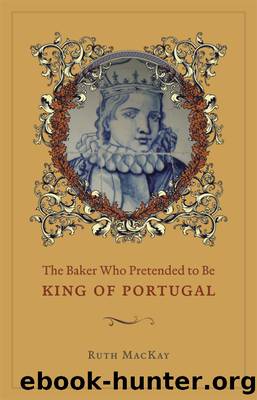The Baker Who Pretended to Be King of Portugal by Ruth MacKay

Author:Ruth MacKay [MacKay, Ruth]
Language: eng
Format: epub
Tags: History, General, Europe, Renaissance, Spain & Portugal
ISBN: 9780226501086
Google: jdGpM3063bIC
Goodreads: 13212179
Publisher: University of Chicago Press
Published: 2012-04-26T00:00:00+00:00
Obstruction of Justice
A few days later, on October 14, quickly armed with a personal judicial commission from the king, Santillán went to Madrigal and got to work. He was convinced that friars and nuns were at the root of the problem, as they generally were: âNever in the history of the world was there a great evil or serious crime in which a religious was not involved,â he would say a few months down the road.30 He arrived in the late afternoon, he told the king, and went directly to the convent. âFearful that if [Ana] had advance warning she might hide papers, I went in saying I had to speak with her on Your Majestyâs orders, and that I particularly wanted to see some windows in her room that open onto the street. I looked for the papers, and though I found many letters, I found none with this yearâs date, nor last yearâs. Instead, I found empty drawers, and I ordered her detained in her rooms with four nuns standing guard.â She was not to write or receive any letters or messages.31 Fray Miguel, too, had cleaned out his desk. Somehow the inhabitants of the convent had received word of Espinosaâs arrest, as we already saw from their detailed knowledge of the jewels he was carrying. Santillán ordered the arrest of around eight individuals named in the letters and held them in various houses in the town, and he also ordered the transfer of Espinosa from Valladolid to Medina del Campo.
Santillánâs forced entry into the religious houses immediately sent Goldaraz into action. On October 17, assisted by Fray AgustÃn Antolinez, Goldaraz staged his preemptive strike with the marathon interrogation of all the friars and nuns to establish what they knew about Espinosa, his relationship with Ana and Fray Miguel, and the little girl.32 Content aside, the fact that the hearing took place at all is indicative of the divide between religious and secular authorities and within the Augustinian order. Sixteenth-century Spain was a deeply litigious place with many overlapping jurisdictions (territorial, seigneurial, ecclesiastical, municipal, inquisitorial, and royal), so it is not surprising that there were attempts from the start to halt such a scandalous case or grab jurisdiction away from other parties. Every judge and jurist who intervened in the caseâaside from Santillán and Llano, there were two others from the royal chancery court, along with Goldaraz, who acted as suchâhad nasty things to say about the rest. As a royal aide put it, âThese judges in Madrigal are raising quite a ruckus.â33 After Santillán rifled through Anaâs papers, or what was leftof them, Goldaraz immediately instructed the nuns and the prioress to bar the judge from entering the convent again.34 Two days later, the king himself ordered Goldarez to quit obstructing justice and allow Fray Miguel (quickly imprisoned in the Mota fortress in Medina) and all the other religious inhabitants to answer Santillánâs questions. The king also summoned Goldaraz and Antolinez to Madrid to meet with him, an encounter we know nothing about.
Download
This site does not store any files on its server. We only index and link to content provided by other sites. Please contact the content providers to delete copyright contents if any and email us, we'll remove relevant links or contents immediately.
| Buddhism | Christianity |
| Ethnic & Tribal | General |
| Hinduism | Islam |
| Judaism | New Age, Mythology & Occult |
| Religion, Politics & State |
Cecilia; Or, Memoirs of an Heiress — Volume 1 by Fanny Burney(32054)
Cecilia; Or, Memoirs of an Heiress — Volume 3 by Fanny Burney(31453)
Cecilia; Or, Memoirs of an Heiress — Volume 2 by Fanny Burney(31402)
The Secret History by Donna Tartt(18151)
Sapiens: A Brief History of Humankind by Yuval Noah Harari(13984)
Leonardo da Vinci by Walter Isaacson(12788)
The Radium Girls by Kate Moore(11616)
Sapiens by Yuval Noah Harari(5118)
How Democracies Die by Steven Levitsky & Daniel Ziblatt(4950)
The Wind in My Hair by Masih Alinejad(4836)
Homo Deus: A Brief History of Tomorrow by Yuval Noah Harari(4682)
Endurance: Shackleton's Incredible Voyage by Alfred Lansing(4496)
The Silk Roads by Peter Frankopan(4266)
Man's Search for Meaning by Viktor Frankl(4266)
Millionaire: The Philanderer, Gambler, and Duelist Who Invented Modern Finance by Janet Gleeson(4089)
The Rape of Nanking by Iris Chang(4020)
Hitler in Los Angeles by Steven J. Ross(3796)
Joan of Arc by Mary Gordon(3781)
The Motorcycle Diaries by Ernesto Che Guevara(3779)
